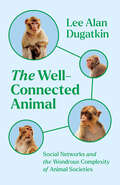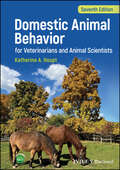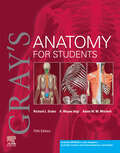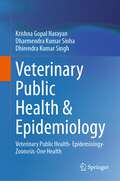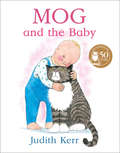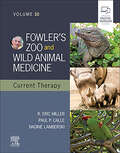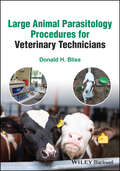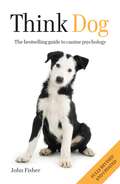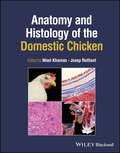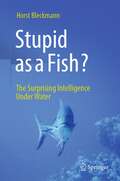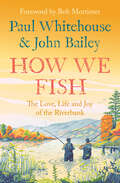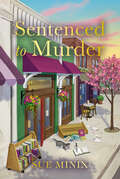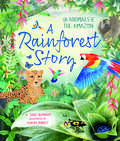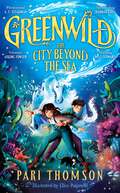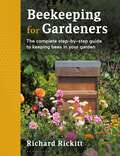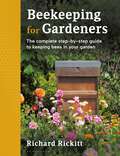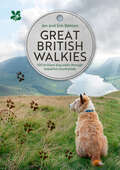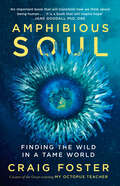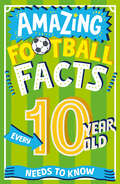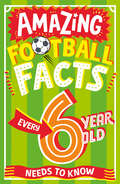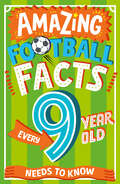- Table View
- List View
The Well-Connected Animal: Social Networks and the Wondrous Complexity of Animal Societies
by Lee Alan DugatkinAn engaging exploration of the wondrous social webs that permeate life in animal societies around the world. It’s all about who you know. Whether vampire bats sharing blood meals for survival, field crickets remembering champion fighters, macaque monkeys forming grooming pacts after a deadly hurricane, or great tit birds learning the best way to steal milk—it pays to be well connected. In this tour of the animal kingdom, evolutionary biologist Lee Alan Dugatkin reveals a new field of study, uncovering social networks that existed long before the dawn of human social media. He accessibly describes the latest findings from animal behavior, evolution, computer science, psychology, anthropology, genetics, and neurobiology, and incorporates interviews and insights from researchers he finds swimming with manta rays, avoiding pigeon poop, and stopping monkeys from stealing iPads. With Dugatkin as our guide, we investigate social networks in giraffes, elephants, kangaroos, Tasmanian devils, whales, bats, and more. From animal networks in Australia and Asia to Africa, Europe, and the Americas, The Well-Connected Animal is an eye-opening exposé of wild friends, enemies, and everything in between.
The Well-Connected Animal: Social Networks and the Wondrous Complexity of Animal Societies
by Lee Alan DugatkinAn engaging exploration of the wondrous social webs that permeate life in animal societies around the world. It’s all about who you know. Whether vampire bats sharing blood meals for survival, field crickets remembering champion fighters, macaque monkeys forming grooming pacts after a deadly hurricane, or great tit birds learning the best way to steal milk—it pays to be well connected. In this tour of the animal kingdom, evolutionary biologist Lee Alan Dugatkin reveals a new field of study, uncovering social networks that existed long before the dawn of human social media. He accessibly describes the latest findings from animal behavior, evolution, computer science, psychology, anthropology, genetics, and neurobiology, and incorporates interviews and insights from researchers he finds swimming with manta rays, avoiding pigeon poop, and stopping monkeys from stealing iPads. With Dugatkin as our guide, we investigate social networks in giraffes, elephants, kangaroos, Tasmanian devils, whales, bats, and more. From animal networks in Australia and Asia to Africa, Europe, and the Americas, The Well-Connected Animal is an eye-opening exposé of wild friends, enemies, and everything in between.
Domestic Animal Behavior for Veterinarians and Animal Scientists
by Katherine A. HouptFully updated revision of a classic text offering a thorough understanding of the normal behavior of domestic animals The Seventh Edition of Domestic Animal Behavior for Veterinarians and Animal Scientists is a fully updated revision of this popular, classic text offering a thorough understanding of the normal behavior of domestic animals. Maintaining the foundation of earlier editions, chapters examine key behavior issues ranging from communication to social structure. The Seventh Edition adds enhanced coverage of behavioral genetics, animal cognition, and learning, considering new knowledge and the very latest information throughout. Each chapter covers a wide variety of farm and companion animals, including dogs, cats, horses, pigs, sheep, cattle, and goats. Major additions are chicken and donkey behavior as well as the microbiome. Each chapter covers a particular behavior subdivided by species. The information has been updated using information published in the past five years. To aid in reader comprehension and assist in self-learning, a companion website provides review questions and answers and the figures from the book in PowerPoint. Sample topics covered in Domestic Animal Behavior for Veterinarians and Animal Scientists include: Communication patterns, perception, vocalization, visual signals, social behavior, sleep and activity patterns, and detection of emotions in others Maternal behavior, pain- and fear-induced aggression, feeding habits, and behavioral problems (such as cribbing, offspring rejection and anxiety) Aggression and social structure, stereotypic behavior, free-ranging versus confined behavior, and maternal behavior (such as recognizing the young) Sexual behavior, development of behavior, and sleep behavior, including ultradian, circadian, annual, and other rhythms Ingestive behavior (food and water intake), hyperactivity and narcolepsy, and overall learning behavior The role of genetics, the environment, and the microbiome in behavior The Seventh Edition of Domestic Animal Behavior for Veterinarians and Animal Scientists is an essential reference for students of animal science and veterinary students, as well as qualified veterinarians and animal scientists seeking a more thorough understanding of the principles of animal behavior.
Domestic Animal Behavior for Veterinarians and Animal Scientists
by Katherine A. HouptFully updated revision of a classic text offering a thorough understanding of the normal behavior of domestic animals The Seventh Edition of Domestic Animal Behavior for Veterinarians and Animal Scientists is a fully updated revision of this popular, classic text offering a thorough understanding of the normal behavior of domestic animals. Maintaining the foundation of earlier editions, chapters examine key behavior issues ranging from communication to social structure. The Seventh Edition adds enhanced coverage of behavioral genetics, animal cognition, and learning, considering new knowledge and the very latest information throughout. Each chapter covers a wide variety of farm and companion animals, including dogs, cats, horses, pigs, sheep, cattle, and goats. Major additions are chicken and donkey behavior as well as the microbiome. Each chapter covers a particular behavior subdivided by species. The information has been updated using information published in the past five years. To aid in reader comprehension and assist in self-learning, a companion website provides review questions and answers and the figures from the book in PowerPoint. Sample topics covered in Domestic Animal Behavior for Veterinarians and Animal Scientists include: Communication patterns, perception, vocalization, visual signals, social behavior, sleep and activity patterns, and detection of emotions in others Maternal behavior, pain- and fear-induced aggression, feeding habits, and behavioral problems (such as cribbing, offspring rejection and anxiety) Aggression and social structure, stereotypic behavior, free-ranging versus confined behavior, and maternal behavior (such as recognizing the young) Sexual behavior, development of behavior, and sleep behavior, including ultradian, circadian, annual, and other rhythms Ingestive behavior (food and water intake), hyperactivity and narcolepsy, and overall learning behavior The role of genetics, the environment, and the microbiome in behavior The Seventh Edition of Domestic Animal Behavior for Veterinarians and Animal Scientists is an essential reference for students of animal science and veterinary students, as well as qualified veterinarians and animal scientists seeking a more thorough understanding of the principles of animal behavior.
Gray's Anatomy for Students E-Book: Gray's Anatomy for Students E-Book (Gray's Anatomy)
by Richard L. Drake A. Wayne Vogl Adam W.M. MitchellConcise, readable text and an outstanding art program make Gray's Anatomy for Students, 5th Edition, your go-to text for essential information in human anatomy. This fully revised volume focuses on the core information medical students need to know, in an easy-access format and with additional multimedia content to facilitate effective study and mastery of the material. A team of expert authors share a wealth of diverse teaching and clinical experience—all enhanced by more than 1,000 innovative, original illustrations by renowned illustrators Richard Tibbitts and Paul Richardson, who capture anatomical features with unrivalled clarity. Helps you understand the practical applications of anatomical concepts through unique coverage of surface anatomy, correlative diagnostic images, and clinical case studies. Contains increased representation of diverse population groups throughout, incorporating a wider range of skin tones and important clinical considerations related to transgender and intersex individuals. Presents anatomy logically by body region – as well as bonus updated eBook chapters for each major body system to facilitate learning from a different perspective. Includes new and improved online materials such as self-assessment questions, medical and physical therapy clinical cases, a unique Interactive Surface Anatomy tool, and more. Provides fully revised and updated clinical content including numerous new In the Clinic boxes, images, and correlates throughout that reflect the latest advances seen in clinical practice. New and updated Clinical Cases are included in the accompanying enhanced eBook. Features an updated neuroanatomy eBook chapter, so you can learn key aspects of this challenging topic in the context of general anatomy. Improves comprehension of complex cranial nerves with a visual map summarizing cranial nerve distribution and function. Offers schematic drawings for key structures and topics in every chapter, providing an additional, simplified approach to introduce each topic—ideal for quick initial understanding and as a guide for your own anatomy drawings. Enables you to quickly review the basic concepts from each chapter with Conceptual Overviews. Evolve Instructor site with a downloadable image bank is available to instructors through their Elsevier sales rep or via request at https://evolve.elsevier.com.
Veterinary Public Health & Epidemiology: Veterinary Public Health- Epidemiology-Zoonosis-One Health
by Krishna Gopal Narayan Dharmendra Kumar Sinha Dhirendra Kumar SinghThis book introduces and reviews the essential principles of Veterinary Public Health, Zoonoses, One Health, principles and applications of epidemiology in studying infectious diseases including foodborne infections and intoxications. The initial chapters discuss the concept and principal functions of Veterinary Public Health. The book further covers the impacts of Veterinary Public Health on human Health particularly in management of zoonoses. The following section discusses theapplication of epidemiology in the study of outbreaks, epidemic, pandemics and their prevention and control strategies. It helps understanding the factors associated with disease causation transmission and spread and also investigate the emergence of antimicrobial resistance. The chapter on foodborne illnesses illustrates how the knowledge of epidemiology is applied in the study of diseases in community, spread of causative agents from farm to fork. The definition, cause, symptoms, management, control and prevention of foodborne infection and intoxication are dealt with.The last chapter introduces the concept, objectives, and definition of One Health and discusses the advancements made and challenges in One Health around endemic and emerging zoonotic diseases.
Mog and the Baby
by null Judith KerrShare in fifty years of a really remarkable cat… Mog is everyone’s favourite family cat! Join her in this warm-hearted and funny escapade about Mog’s first meeting with a baby… as read by Tacy Kneale, and as a full-colour ebook! Celebrate the fiftieth anniversary of Mog the Forgetful Cat with special anniversary editions of her much-loved adventures. From the creator of The Tiger Who Came to Tea and Mog the Forgetful Cat comes a delightful family adventure about a really remarkable cat! Read by Tacy Kneale and as a full-colour ebook. Mog's peaceful day is shattered when a baby comes to visit. All Mog wants to do and sleep and play but there is no chance of that now… "Mog loves babies," says Mrs Thomas but suddenly Mog isn't quite so sure! Mog the Forgetful Cat was first published fifty years ago, and Mog has been delighting children all over the world with her adventures ever since. These books are the perfect gifts for boys, girls and families everywhere!
Fowler's Zoo and Wild Animal Medicine Current Therapy, Volume 10: Fowler's Zoo and Wild Animal Medicine Current Therapy, Volume 10 - E-Book
by R. Eric Miller Paul P. Calle Nadine LamberskiGet the latest advances in zoo and wild animal medicine in one invaluable reference! Written by internationally recognized experts, Fowler's Zoo and Wild Animal Medicine: Current Therapy, Volume 10 provides a practical guide to the latest research and clinical management of captive and free-ranging wild animals. For each animal, coverage includes topics such as biology, anatomy and special physiology, reproduction, restraint and handling, housing requirements, nutrition and feeding, surgery and anesthesia, diagnostics, and treatment protocols. New topics in this edition include holistic treatments, antibiotic resistance in aquariums, non-invasive imaging for amphibians, emerging reptile viruses, and African ground hornbill medicine, in addition to giant anteater medicine, Brucella in marine animals, and rhinoceros birth parameters. With coverage of many subjects where information has not been readily available, Fowler’s is a resource you don’t want to be without. Fowler's Current Therapy format ensures that each volume in the series covers all-new topics with timely information on current topics of interest in the field. Focused coverage offers just the right amount of depth — often fewer than 10 pages in a chapter — which makes the material easier to access and easier to understand. General taxon-based format covers all terrestrial vertebrate taxa plus selected topics on aquatic and invertebrate taxa. Updated information from the Zoological Information Management System (ZIMS) includes records from their growing database for 2.3 million animals (374,000 living) and 23,000 taxa, which can serve as a basis for new research. Expert, global contributors include authors from the U.S. and 25 other countries, each representing trends in their part of the world, and each focusing on the latest research and clinical management of captive and free-ranging wild animals. NEW! All-new topics and contributors ensure that this volume addresses the most current issues relating to zoo and wild animals. NEW! Content on emerging diseases includes topics such as COVID-19, rabbit hemorrhagic disease, yellow fever in South American primates, monitoring herpesviruses in multiple species, and canine distemper in unusual species. NEW! Emphasis on management includes coverage of diversity in zoo and wildlife medicine. NEW! Panel of international contributors includes, for the first time, experts from Costa Rica, Estonia, Ethiopia, India, Norway, and Singapore, along with many other countries. NEW! Enhanced eBook version is included with each print purchase, providing a fully searchable version of the entire text and access to all of its text, figures, and references.
Large Animal Parasitology Procedures for Veterinary Technicians
by Donald H. BlissLarge Animal Parasitology Procedures for Veterinary Technicians Comprehensive illustrated reference on parasitic nematodes, cestodes, coccidian oocysts and trematode egg recoveries, identification, and enumeration with treatment strategies for five separate categories of animal patients Large Animal Parasitology Procedures for Veterinary Technicians illustrates, in detail, the most sensitive diagnostic procedure for internal parasites of domestic animals using the Modified Wisconsin Sugar Flotation Method. With step-by-step pictures and bullet-point instructions, this text discusses sample collection and storage techniques, as well as the strengths and weaknesses inherent to other commonly used tests. Potential sources for infection, the seasonality of the infection, possible environmental recontamination, and control strategies are all covered in detail, with suggestions to prevent reoccurrences. Parasites of the equine, large and small ruminants (including alpaca), swine, poultry and hoofed wildlife patients are included, with full color images for quick identification, an assessment of life cycle stage, and discussion of zoonotic potential. Each species section is heavily illustrated with comparative images to aid the technician in quickly identifying the parasite and life cycle stage. In Large Animal Parasitology Procedures for Veterinary Technicians, readers can find information on: The definition and economic importance of parasitisms, details on the epidemiology of parasitic enteritis, including basics of protozoology, helminthology, and overall applied veterinary parasitology Sample collection and shipment of specimens, including collection, storage, examinations, and interpretations Fecal examination using the Modified Wisconsin Sugar Flotation method, compared with gross examination, smear, sedimentation, and other flotation techniques, plus a fluke egg recovery technique and the Baermann technique for lungworm larvae recovery Internal parasite diagnosis and worm egg recoveries, descriptions and pictures of nematode parasite eggs (as well as coccidia oocysts), plus tapeworm eggs and fluke egg descriptions and photos for a variety of host animals Illustrating commonly used diagnostic tests in veterinary parasitology, with step-by-step instructions for accuracy, Large Animal Parasitology Procedures for Veterinary Technicians is an essential reference for veterinary technicians and veterinary technician students dealing with domestic animals, including horses, ruminants, swine, poultry, and hoofed wildlife.
Large Animal Parasitology Procedures for Veterinary Technicians
by Donald H. BlissLarge Animal Parasitology Procedures for Veterinary Technicians Comprehensive illustrated reference on parasitic nematodes, cestodes, coccidian oocysts and trematode egg recoveries, identification, and enumeration with treatment strategies for five separate categories of animal patients Large Animal Parasitology Procedures for Veterinary Technicians illustrates, in detail, the most sensitive diagnostic procedure for internal parasites of domestic animals using the Modified Wisconsin Sugar Flotation Method. With step-by-step pictures and bullet-point instructions, this text discusses sample collection and storage techniques, as well as the strengths and weaknesses inherent to other commonly used tests. Potential sources for infection, the seasonality of the infection, possible environmental recontamination, and control strategies are all covered in detail, with suggestions to prevent reoccurrences. Parasites of the equine, large and small ruminants (including alpaca), swine, poultry and hoofed wildlife patients are included, with full color images for quick identification, an assessment of life cycle stage, and discussion of zoonotic potential. Each species section is heavily illustrated with comparative images to aid the technician in quickly identifying the parasite and life cycle stage. In Large Animal Parasitology Procedures for Veterinary Technicians, readers can find information on: The definition and economic importance of parasitisms, details on the epidemiology of parasitic enteritis, including basics of protozoology, helminthology, and overall applied veterinary parasitology Sample collection and shipment of specimens, including collection, storage, examinations, and interpretations Fecal examination using the Modified Wisconsin Sugar Flotation method, compared with gross examination, smear, sedimentation, and other flotation techniques, plus a fluke egg recovery technique and the Baermann technique for lungworm larvae recovery Internal parasite diagnosis and worm egg recoveries, descriptions and pictures of nematode parasite eggs (as well as coccidia oocysts), plus tapeworm eggs and fluke egg descriptions and photos for a variety of host animals Illustrating commonly used diagnostic tests in veterinary parasitology, with step-by-step instructions for accuracy, Large Animal Parasitology Procedures for Veterinary Technicians is an essential reference for veterinary technicians and veterinary technician students dealing with domestic animals, including horses, ruminants, swine, poultry, and hoofed wildlife.
Think Dog: The bestselling guide to canine psychology
by John FisherIn this seminal pet psychology book, John Fisher examines the mind of the dog with examples taken from his practical experience, with the aim of explaining to owners how the world appears from a dog's point of view.The first section of the book traces the ancestry and inherent behaviour of dogs, from their origins as pack animals related to the wolf or the jackal. The second part examines what most people describe as problem behaviour, which is just normal canine behaviour exhibited in the wrong place. The book concludes with an A-Z of common problems, their causes and cures.In the 1980s and 1990s John Fisher revolutionised dog training, first in England, then in the US. With his self-deprecating manner and 'Oh! So British' sense of humour he taught us to 'Think Dog'.
Anatomy and Histology of the Domestic Chicken
by Wael Khamas Josep RutllantComprehensive reference describing in-depth physical anatomy and histology of domestic avian species chicken, depicted through high quality macro- and micro-photographs Atlas of Anatomy and Histology of the Domestic Chicken is a state-of-the-art atlas of avian anatomy that provides a complete collection of both original gross anatomy and histology photographs and texts of all body systems of the birds based on the domestic chicken to depict anatomic features. Using cutting-edge technology to create visualizations of anatomic structure, this specialist reference includes both gross anatomical structures/organs and their histological details next to each other. This approach enables readers to understand the macro- and micro-pictures of each organ/structure under study. The text includes a total of more than 200 high-resolution, high quality color images and diagrams. Written by two highly qualified professors with significant experience in the field, Anatomy and Histology of the Domestic Chicken includes information on: External features of the body, including regions, features, ornaments, shape, feathers, skin, and the uropygial gland Musculoskeletal characteristic including cartilage and bone formation and classification, flight and ambulatory muscles Digestive system, including the beak, esophagus, crop, proventriculus, ventriculus, intestines, and accessory glands Respiratory system, including external nares, the nasal cavity, trachea, upper larynx, syrinx, lungs, and air sacs Urinary system, including kidneys and the ureter, cloaca-urodeum, and genital system, covering differences between males and females Endocrine system, including pituitary, pineal, adrenal, pancreas, thyroid, and parathyroid glands Nervous system with central and peripheral divisions and sense organs including eye and ear Lymphatic system, with descriptions of the primary and secondary lymphatic organs Egg anatomy and development of the chick embryo Applied anatomical concepts important for clinical maneuvers and necropsy With comprehensive coverage of the subject and highly detailed photographs included throughout the text, Anatomy and Histology of the Domestic Chicken is an indispensable resource for breeders, veterinarians, researchers, avian biologists, pathologists, and students in animal sciences and veterinary fields.
Stupid as a Fish?: The Surprising Intelligence Under Water
by Horst BleckmannCompared to mammals, fish are often underestimated and dismissed as less complex organisms. To refute this hasty conclusion, Horst Bleckmann presents to you the highly developed cognitive abilities of fish.Did you know, for example, that fish are the largest group of all vertebrates, with about 30,000 species, and that they colonize all aquatic habitats? For this immense feat, they have evolved a variety of highly specialized sensory systems and behaviors. According to recent research, fish also possess not only extremely sophisticated sensory organs, but also highly developed central nervous systems that are similar in basic structure to the brains of mammals.Immerse yourself in a fascinating world and learn all about the different sensory systems of fish. A concluding chapter additionally covers the global threat to fish from water pollution, cross-building in flowing waters, and the fishing industry.
How We Fish: The new book from the fishing brains behind the hit TV series GONE FISHING, with a Foreword by Bob Mortimer
by null Paul Whitehouse null John BaileyPaul Whitehouse and fishing expert John Bailey celebrate the timeless joy of fishing. Paul Whitehouse and John Bailey have been devout fishermen for longer than they care to remember. A hobby, past time or sport – call it what you want – they have felt the pull of the water ever since they were kids and have never missed the chance to set up on the bank and try their luck. In this wonderful book, the two fishermen collaborate to celebrate the rich tapestry that is fishing – from mentors to memories; from philosophy to modern jargon; from watercraft to becoming self-styled ‘Fishing Detectives’. Punctuated by brilliant stories, beautiful illustrations by Carys Reilly-Whitehouse, and recollections from fishing day trips past, How We Fish is the perfect tome for the veteran fisherman or the budding angler – warm, funny and rich in the wonders of the riverbank.
Anatomy and Histology of the Domestic Chicken
by Wael Khamas Josep RutllantComprehensive reference describing in-depth physical anatomy and histology of domestic avian species chicken, depicted through high quality macro- and micro-photographs Atlas of Anatomy and Histology of the Domestic Chicken is a state-of-the-art atlas of avian anatomy that provides a complete collection of both original gross anatomy and histology photographs and texts of all body systems of the birds based on the domestic chicken to depict anatomic features. Using cutting-edge technology to create visualizations of anatomic structure, this specialist reference includes both gross anatomical structures/organs and their histological details next to each other. This approach enables readers to understand the macro- and micro-pictures of each organ/structure under study. The text includes a total of more than 200 high-resolution, high quality color images and diagrams. Written by two highly qualified professors with significant experience in the field, Anatomy and Histology of the Domestic Chicken includes information on: External features of the body, including regions, features, ornaments, shape, feathers, skin, and the uropygial gland Musculoskeletal characteristic including cartilage and bone formation and classification, flight and ambulatory muscles Digestive system, including the beak, esophagus, crop, proventriculus, ventriculus, intestines, and accessory glands Respiratory system, including external nares, the nasal cavity, trachea, upper larynx, syrinx, lungs, and air sacs Urinary system, including kidneys and the ureter, cloaca-urodeum, and genital system, covering differences between males and females Endocrine system, including pituitary, pineal, adrenal, pancreas, thyroid, and parathyroid glands Nervous system with central and peripheral divisions and sense organs including eye and ear Lymphatic system, with descriptions of the primary and secondary lymphatic organs Egg anatomy and development of the chick embryo Applied anatomical concepts important for clinical maneuvers and necropsy With comprehensive coverage of the subject and highly detailed photographs included throughout the text, Anatomy and Histology of the Domestic Chicken is an indispensable resource for breeders, veterinarians, researchers, avian biologists, pathologists, and students in animal sciences and veterinary fields.
Sentenced to Murder (The Bookstore Mystery Series)
by null Sue MinixShe’s written murder mysteries before, but can she solve this real life cold case? Just as Jen sits down to start writing her next murder mystery novel, she stumbles across a chilling real-life case: a man who claims he’s been wrongly convicted for murder. Time is running out for Jaylon as he needs a kidney transplant to save his life, something he’ll never receive while he’s in prison for murder. Jen’s amateur sleuthing skills are pushed to their very limit as time is ticking to solve Jaylon’s case and save his life. Can she save him before his sentence to murder becomes a sentence to death? This bookish cozy mystery is perfect for fans of Agatha Christie and Ellery Adams, and will leave you guessing right up until the final page.
A Rainforest Story: The Animals of the Amazon (An Arctic Story series)
by Jane BurnardThis beautiful book brings together amazing facts about rainforests, a heart-warming narrative and breathtaking illustrations.Explore the vibrant life of the rainforest, from the fierce predators that roam the forest floor to the brightly-coloured birds that fly above the trees. Traveling through the seasons, we meet various rainforest creatures as they are born, raise their young and settle down to hibernate through the hottest months.Learn about the behavior of favorite big cats such as the beautiful jaguar, and beloved animals such as capybaras and sloths. Discover how animals and plants work together to survive and thrive, like the monkeys that go from flower to flower, feeding on nectar and spreading pollen.Beautiful descriptions of dynamic rainforest creatures are further animated by colourful illustrations that will leave children and adults poring over the pages of this book.
Greenwild: The City Beyond the Sea (Greenwild #2)
by Pari ThomsonAcross the ocean, a magical adventure awaits in The City Beyond the Sea, the spellbinding, beautifully-illustrated sequel to Overall Waterstones Children's Book Prize winner and Blackwell's Children's Book of the Year, Greenwild: The World Behind the Door by Pari Thomson.'Phenomenal . . . If you don’t believe in magic, you will after you’ve read Greenwild' - A. F. Steadman, author of the Skandar series'A spectacular, sweeping fantasy filled with intrigue - secret cities, magic, and mystery . . . a book bursting with heart and courage' - Rashmi Sirdeshpande Daisy Thistledown is on a mission. She might have defeated a terrible enemy, but her journey to find her kidnapped mother is just beginning. After smuggling aboard a long-awaited expedition to the heart of theAmazon, Daisy and her friends soon find themselves in danger on the high seas, pursued across the waves by Grim Reapers. Their only hope: to find the legendary Iffenwild, a mysterious city hidden beyond the sea and lost to time.But a strange, wild magic is stirring beneath the waves. It will take all of Daisy’s courage and determination – and the trust of a new friend – if she is to discover the truth that haunts Iffenwild, and save the magical world before it’s too late.'An eco-thriller every child should read' - The Telegraph on Greenwild: The World Behind the Door
Beekeeping for Gardeners: The complete step-by-step guide to keeping bees in your garden
by Richard RickittA comprehensive gardener's guide to sustainable beekeeping.Beekeeping has changed. While once it was a hobby that pursued the rich rewards of honey and wax, many new beekeepers now instead seek the gratification of knowing that they are aiding the survival of one of the world's most important creatures. Keeping bees today is as much about providing the right habitats and resources to help pollinators thrive as it is about chasing every drop of golden honey.This beautifully illustrated guide to the ancient hobby of beekeeping shows today's gardeners how to create beautiful gardens that are richly rewarding for people and bees alike. Flowers, shrubs, trees and vegetable plots can provide colourful beauty and delicious produce as well as vital pollen and nectar when bees need it the most. There are lists of the top-performing plants and how and where to grow them, including window boxes, lawns, borders, wild gardens and even ponds.Beekeeping for Gardeners looks at the pleasures and benefits of keeping honey bees in gardens of all types and sizes, both rural and urban. It explains the practicalities involved in keeping bees in the domestic garden setting, as well as on rooftops, allotments, parks, farmland and other locations. Importantly, and unlike any book before, this guide sets the delightful hobby of beekeeping within the context of the wider environment, asking how it can best serve the needs of all types of pollinator and the local ecology in general.Whether you're looking to attract more bumblebees and solitary bees or want to install a beehive, this wonderful book contains all the guidance you'll need to have a garden buzzing with bees.
Beekeeping for Gardeners: The complete step-by-step guide to keeping bees in your garden
by Richard RickittA comprehensive gardener's guide to sustainable beekeeping.Beekeeping has changed. While once it was a hobby that pursued the rich rewards of honey and wax, many new beekeepers now instead seek the gratification of knowing that they are aiding the survival of one of the world's most important creatures. Keeping bees today is as much about providing the right habitats and resources to help pollinators thrive as it is about chasing every drop of golden honey.This beautifully illustrated guide to the ancient hobby of beekeeping shows today's gardeners how to create beautiful gardens that are richly rewarding for people and bees alike. Flowers, shrubs, trees and vegetable plots can provide colourful beauty and delicious produce as well as vital pollen and nectar when bees need it the most. There are lists of the top-performing plants and how and where to grow them, including window boxes, lawns, borders, wild gardens and even ponds.Beekeeping for Gardeners looks at the pleasures and benefits of keeping honey bees in gardens of all types and sizes, both rural and urban. It explains the practicalities involved in keeping bees in the domestic garden setting, as well as on rooftops, allotments, parks, farmland and other locations. Importantly, and unlike any book before, this guide sets the delightful hobby of beekeeping within the context of the wider environment, asking how it can best serve the needs of all types of pollinator and the local ecology in general.Whether you're looking to attract more bumblebees and solitary bees or want to install a beehive, this wonderful book contains all the guidance you'll need to have a garden buzzing with bees.
Great British Walkies (National Trust)
by National Trust BooksDog-friendly country walks in Britain with places to eat and stay Supported by the National Trust, and includes their ‘pawprint rating’ system for dog-friendly places Breathtaking walks that aren’t too challenging – 2-6 miles in length. Suggested stops. Walks are created with dogs in mind – all the info you need. Don’t just take your dog for a walk. Take your dog for one of Britain’s 100 best dog walks. These country routes are custom-made for you and your four-legged friend. Ranging from 2 to 6 miles, they cover the whole of the UK and take some of our most beautiful woods, coast, rolling hills and fields, not to mention fascinating and inspiring historic sites. For each walk, there’s a map and comprehensive directions, plus information on whether and where a lead is needed and suggestions for dog-friendly refreshment stops and accommodation nearby.
Amphibious Soul: Finding the wild in a tame world
by null Craig FosterAn awe-inspiring narrative about the power of nature and our place within it, from the creator of My Octopus Teacher, filmmaker Craig Foster “Amphibious Soul is an important book. . . . This book isn't about learning how to be wild but rather a guide to recognizing and reconnecting with the wild in and around us. It is a book that will inspire hope.” – Jane Goodall An adventure story, love story, travelogue, naturalist memoir, and spiritual guide, Craig Foster's Amphibious Soul is a scientist and adventurer’s perspective on “rewilding”—developing a deep connection to our animal selves that can reinvigorate our lives. Told in Craig’s warm and passionate voice, this extraordinary book will change not only the way we interact with the natural world, but the way we fundamentally see ourselves. A decade ago, living in a city and feeling exhausted and empty, Craig decided to return to his birthplace—the Cape of Good Hope—and dive into the great African Sea forest each day. His daily oceanic adventures not only helped him “rewild”, but helped him come to see his own “amphibious soul” as a powerful metaphor for the human condition. We homo sapiens are by nature wild animals attempting to exist in a docile world. So how can we reclaim our wildness in a world that wants us to stay so tamed? An extraordinary literary work, Amphibious Soul is a riveting narrative filled with meticulous descriptions of an adventure in the natural world that speaks to readers on an intimate level, challenging us to consider our personal relationship to nature, and inspiring us to realign our daily practices to help save the global ecosystem. Whether we live close to nature or in an urban jungle, Craig shows us how to nurture our individual wildness, tap into our empathy, and deepen our love for all living things. He teaches us to track the wild around us, and by doing so become present in the moment and revel in being wondrously alive. Featuring breathtaking original photos and QR codes that access mini-videos of never-seen-before animal interactions, Amphibious Soul is a remarkable experience that will transform us and ultimately our world.
Amazing Football Facts Every 10 Year Old Needs to Know (Amazing Facts Every Kid Needs to Know)
by null Caroline RowlandsPack your brain with football fun and trivia ahead of the UEFA EURO 2024 championship! Discover over 100 extraordinary facts about the beautiful game from all around the world! Find out which football teams travelled to the first ever FIFA World Cup together. Discover the world record for the lowest altitude football match. Meet the king who named one of the world’s most famous football clubs. From jaw-dropping goals to the silliest celebrations, this fun-filled, stat-packed book has everything you need to know about your favourite football stars and the pioneering players who paved their way. Fully illustrated throughout! Look out for more Amazing Facts books:Amazing Facts Every 6 Year Old Needs to KnowAmazing Facts Every 7 Year Old Needs to KnowAmazing Facts Every 8 Year Old Needs to KnowAmazing Facts Every 9 Year Old Needs to KnowAmazing Facts Every 10 Year Old Needs to Know
Amazing Football Facts Every 6 Year Old Needs to Know (Amazing Facts Every Kid Needs to Know)
by null Caroline RowlandsPack your brain with football fun and trivia ahead of the UEFA EURO 2024 championship! Discover over 100 extraordinary facts about the beautiful game from all around the world! Find out which football team plays inside a crocodile-shaped stadium. Discover which famous footballers went to the same school. Meet the legendary manager who’s never been sacked! From jaw-dropping goals to the silliest celebrations, this fun-filled, stat-packed book has everything you need to know about your favourite football stars and the pioneering players who paved their way. Fully illustrated throughout! Look out for more Amazing Facts books: Amazing Facts Every 6 Year Old Needs to Know Amazing Facts Every 7 Year Old Needs to Know Amazing Facts Every 8 Year Old Needs to Know Amazing Facts Every 9 Year Old Needs to Know Amazing Facts Every 10 Year Old Needs to Know
Amazing Football Facts Every 9 Year Old Needs to Know (Amazing Facts Every Kid Needs to Know)
by null Caroline RowlandsPack your brain with football fun and trivia ahead of the UEFA EURO 2024 championship! Discover over 100 extraordinary facts about the beautiful game from all around the world! Find out which women’s football team is ranked No. 1 in the world. Discover the story behind the animal that found a stolen FIFA World Cup trophy. Meet the legendary footballer who signed their first professional contract on a napkin. From jaw-dropping goals to the silliest celebrations, this fun-filled, stat-packed book has everything you need to know about your favourite football stars and the pioneering players who paved their way. Fully illustrated throughout! Look out for more Amazing Facts books:Amazing Facts Every 6 Year Old Needs to KnowAmazing Facts Every 7 Year Old Needs to KnowAmazing Facts Every 8 Year Old Needs to KnowAmazing Facts Every 9 Year Old Needs to KnowAmazing Facts Every 10 Year Old Needs to Know
